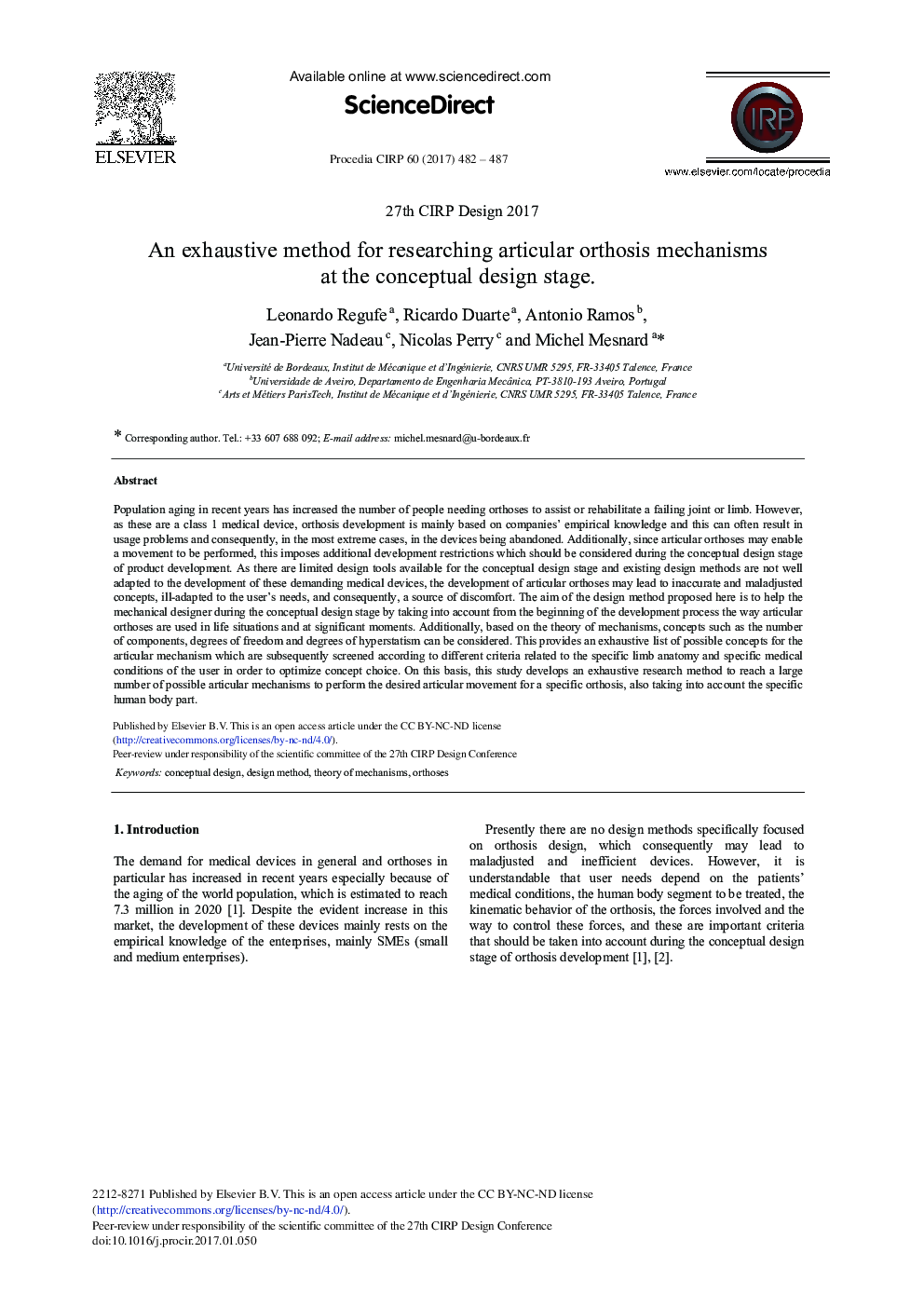| کد مقاله | کد نشریه | سال انتشار | مقاله انگلیسی | نسخه تمام متن |
|---|---|---|---|---|
| 5470655 | 1519292 | 2017 | 6 صفحه PDF | دانلود رایگان |
عنوان انگلیسی مقاله ISI
An Exhaustive Method for Researching Articular Orthosis Mechanisms at the Conceptual Design Stage
ترجمه فارسی عنوان
یک روش جامع برای بررسی مکانیزم های ارتودنسی مفصلی در مرحله طراحی مفهومی
دانلود مقاله + سفارش ترجمه
دانلود مقاله ISI انگلیسی
رایگان برای ایرانیان
کلمات کلیدی
طراحی مفهومی، روش طراحی، نظریه مکانیسم، ارتزها،
ترجمه چکیده
پیری جمعیت در سال های اخیر تعداد افرادی که نیازمند ارتزها هستند، به منظور کمک به یا بازسازی یک مفصل یا اندام شکست خورده افزایش یافته است. با این حال، به عنوان آنها یک دستگاه پزشکی کلاس 1 است، توسعه ارتز اساسا بر اساس دانش تجربی شرکت ها است و اغلب می تواند منجر به مشکلات استفاده و در نتیجه، در موارد شدید، در دستگاه های رها شده است. علاوه بر این، از آنجا که ارتشی مفصلی ممکن است یک جنبش را انجام دهد، این محدودیت توسعه بیشتری را به وجود می آورد که باید در مرحله طراحی مفهومی توسعه محصول مورد توجه قرار گیرد. همانطور که ابزار طراحی محدود برای مرحله طراحی مفهومی وجود دارد و روش های طراحی موجود به خوبی برای توسعه این وسایل پزشکی مورد نیاز سازگار نیستند، توسعه ارتس مفصلی ممکن است منجر به مفاهیم نادرست و ناسازگار شود، ناسازگار با نیازهای کاربر، و در نتیجه، یک منبع ناراحتی. هدف از روش طراحی پیشنهاد شده در اینجا، کمک به طراح مکانیک در مرحله طراحی مفهومی با در نظر گرفتن ابتدای فرایند توسعه، نحوه استفاده از ورتس مفصلی در شرایط زندگی و در لحظات معینی است. علاوه بر این، بر اساس تئوری مکانیزم، مفاهیمی نظیر تعداد اجزای، درجه آزادی و درجه هیپراستایی می تواند مورد توجه قرار گیرد. این لیست جامعی از مفاهیم احتمالی مکانیزم مفصلی را فراهم می کند که سپس با توجه به معیارهای مختلف مربوط به آناتومی خاص اندام و شرایط پزشکی خاص به منظور بهینه سازی انتخاب مفهوم، نمایش داده می شود. بر این اساس، این مطالعه یک روش تحقیق جامع برای رسیدن به تعداد زیادی از مکانیسم های مفصلی ممکن برای انجام حرکات مفصلی مطلوب برای یک ارتز خاص، همچنین با توجه به بخش خاص بدن انسان است.
موضوعات مرتبط
مهندسی و علوم پایه
سایر رشته های مهندسی
مهندسی صنعتی و تولید
چکیده انگلیسی
Population aging in recent years has increased the number of people needing orthoses to assist or rehabilitate a failing joint or limb. However, as these are a class 1 medical device, orthosis development is mainly based on companies' empirical knowledge and this can often result in usage problems and consequently, in the most extreme cases, in the devices being abandoned. Additionally, since articular orthoses may enable a movement to be performed, this imposes additional development restrictions which should be considered during the conceptual design stage of product development. As there are limited design tools available for the conceptual design stage and existing design methods are not well adapted to the development of these demanding medical devices, the development of articular orthoses may lead to inaccurate and maladjusted concepts, ill-adapted to the user's needs, and consequently, a source of discomfort. The aim of the design method proposed here is to help the mechanical designer during the conceptual design stage by taking into account from the beginning of the development process the way articular orthoses are used in life situations and at significant moments. Additionally, based on the theory of mechanisms, concepts such as the number of components, degrees of freedom and degrees of hyperstatism can be considered. This provides an exhaustive list of possible concepts for the articular mechanism which are subsequently screened according to different criteria related to the specific limb anatomy and specific medical conditions of the user in order to optimize concept choice. On this basis, this study develops an exhaustive research method to reach a large number of possible articular mechanisms to perform the desired articular movement for a specific orthosis, also taking into account the specific human body part.
ناشر
Database: Elsevier - ScienceDirect (ساینس دایرکت)
Journal: Procedia CIRP - Volume 60, 2017, Pages 482-487
Journal: Procedia CIRP - Volume 60, 2017, Pages 482-487
نویسندگان
Leonardo Regufe, Ricardo Duarte, Antonio Ramos, Jean-Pierre Nadeau, Nicolas Perry, Michel Mesnard,
